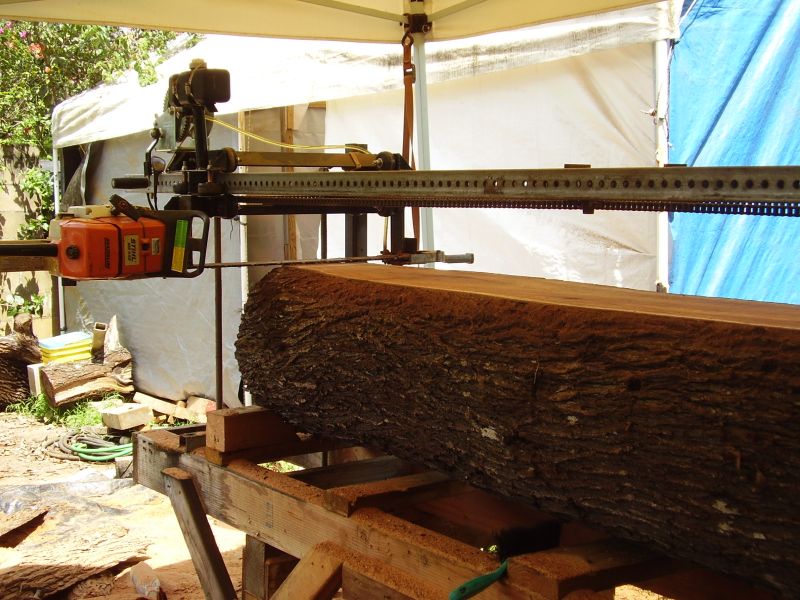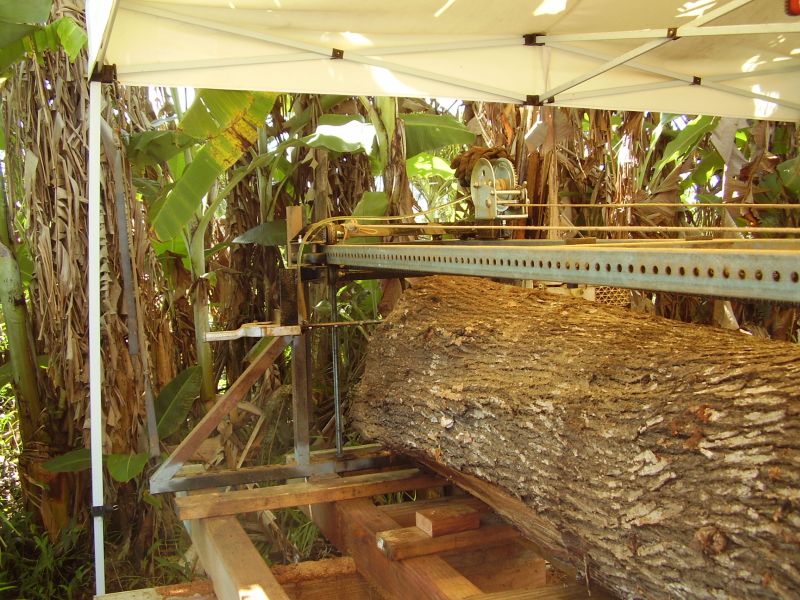What's a Chainsaw Mill Good For?
Chainsaw mills have their particular strengths. Here's a long discussion on how to get good use out of one. March 31, 2008
Question
I'm considering the purchase of a chainsaw sawmill (believe that's what it's called). I could use some advice on what type to purchase and how to use. Since we do not have a sawyer close by and we are cutting very little, we feel this type of machine is the way to go.
Forum Responses
(Sawing and Drying Forum)
From contributor J:
Look for an opportunity to try one before buying. They're neat insofar as they can be stored and transported easily, but I get the impression that they're a terribly inefficient way to cut any amount of lumber. They had one hanging on the wall at school (Redwoods), but never took it down the year I was there. I was told they sometimes cut a little lumber just to give students an idea of the process, but that it was "a lot of work," taking all day to cut one log.
From contributor R:
I'd say it depends on what you are milling. Boxed heart beams, framing lumber, hardwood, softwood, big logs or dinky logs... Is there a commercial mill in your area? If so, they may mill your logs if you're sure there's no steel and they're saw/tie logs. You can go as simple as a Granberg/Alaskan mill or move up to a Logosol or Procut. Hearing protection, flexibility, chain sharpening ability and a lot of free time are the basic requirements.
From contributor M:
I have sawed a lot of wood with my Alaskan powered with a Stihl 090. It is a lot of work. But I have sawed boards up to 4' wide that would be difficult to saw with other types of mills. It is painful, slow, and not something I would consider doing full time, but for the occasional large log, I will put forth the effort. The 090 is not available in the states any longer due to its lack of safety features, but it pulls the chain nicely through big logs.
From contributor P:
I have a couple of Stihl 090 engines and two Granberg Alaskan mills. I bought one new four years ago, when they could be had through dealers in Canada. On Ebay these can bring up to $1300 for very used ones!
If you want to go a little smaller, the Stihl 066 and the Husqvarna 395 are good units. They would do well on logs up to 24" in diameter. Put one on a 36" Alaskan Granberg frame and you're in business. Older Stihl 084, 075 and Husky 394 models could also serve well, if they are not worn out. I have an old Stihl 075 which was an Ebay purchase. I took a chance on it, because it had a major case repair (done by welding the handle back to the case). Fortunately my gamble got me a good price, and it paid off. That saw will cut a 40" oak and not even blink. The weld has held up well.
Do you already have a big chainsaw engine? So much the better. You need something around 90cc or better. The 090 Stihl is 138cc and has super torque! The modern Stihl 088/880 has much higher RPM, as does the Husky 3120. The mill frame from Granberg is the least of your costs.
From contributor U:
Chainsaw milling is a very useful practice to produce a very specific and unique product. If what you want to make are wide flitches (slabs) for tabletops, benches, mantels or cut timbers in a remote location, then the CSM is the way to go. For cutting slabs, they're tops. I've been running a Husky 3120 with a Granberg Alaskan mill for close to two years now and have made some really neat lumber that I couldn't have cut any other way. That said, if what you want to do is produce dimensional lumber, consider an entry level bandmill. You'll produce more lumber with less effort. Chainsaw milling is a sport best suited to strapping young lads, and older fellows suited to a life of treachery. Unless you fit into one of those two categories, or better yet both, get a bandmill.
From contributor C:
I own both a CSM and bandmill. I only use the CSM for wide slabs. If you plan to do more than a couple hundred bdft a year, I would go with a bandmill unless you are only cutting slabs. After buying the mill and a power head to run it, you're looking at near the same money as some of the very small bandmills on the market.
From contributor D:
I have a band mill, Granberg Alaska mill and a Logosol. I agree that the Alaska mill is great for slabbing wood too large for the band mill - I got it for a 4' diameter walnut log, and it more than paid for itself with that one job. A good sharp ripping chain (10 degree tooth angle, full skip) is vital to using the mill. I've run it with a Husq 372 cutterhead on both ends of the bar, which works, if you've got steady nerves and good help. Logosol works great for small and odd-shaped pieces, such as gunstock blanks. Again, a sharp ripping chain makes all the difference. Either chainsaw mill would be okay for limited cutting on a budget. Even if you decide to get a band mill, you'd probably keep the chainsaw mill for special jobs.
From contributor A:
Yeah, starting with a specific chainsaw mill is great (for cutting big slabs), but if you want to make lumber, look to the swing mill. No turning the log, any size log will cut perfectly, and no edger needed... Get an older Lucas or Peterson. I have an old Lucas 825. My son and myself with a good log can cut above 700 bf/hour. Easy on the pocketbook too.
From contributor P:
I have done both chainsaw milling and swingblade. I still own both. Believe me, the chainsaw mill only comes out when I want big slabs. My Peterson 10" WPF will make 20" wide slabs, and I don't own the slabber for it, so on occasion I will pull out the big Stihl 090 with Alaskan frame and make a few slabs.
A swingblade is very versatile. Your cheapest way out with reasonable production is either a swinger or an inexpensive used manual band mill (only if you plan to normally cut normal logs, meaning 18" in diameter and maybe 12' long). Swingers will handle logs from 48" max to over five feet diameter, depending upon the brand and model you get.
From contributor L:
Just a tip on easier chainsaw mill use. I have added a winch and trigger control so once the mill is started in the log, I can go to the other end and pull it through the log while controlling the trigger, control the angle. I'm out of the sawdust and smoke and sometimes can sit. The winch is usually attached to another log or off cut. In hindsight it might have been cheaper to hire a bandsaw mill sometimes, but the ones around here can't cut as wide or get to some of the places I've sawed logs.
From contributor P:
The winch mentioned is handy. I made one based upon Will Malloff's in his book 'Chainsaw Lumbermaking' by Taunton Press. It has many tricks.
From contributor Y:
After using my grandfather's Alaskan mill for two years to cut small quantities of koa, I realized that what took the longest was the setup, not the sawing. So I built my own for around 500 bucks. The whole carriage and power head raise and lower with a chain driven 4 post threaded rod system similar to a planer table, while back and forth is done with the boat winch. I just turn, hold the trigger, and turn the crank to pull the saw through. It takes about 4 minutes to cut 14 inches wide by 7 feet long. Koa is the same hardness as black walnut. The power head is too small for what I am cutting right now, so I am thinking about upgrading the saw for better productivity. On a good day I can saw 3 or 4 27 inch by 7 foot logs by myself including loading the logs. May not seem like much but I am not racing anyone. This mill is not portable right now so I still use my grandfather's Alaskan for longer logs that I can not get in my trailer.

Click here for higher quality, full size image
Another picture from before the cut.

Click here for higher quality, full size image
From contributor M:
It is nice to see a warm place, if only in pictures. How do you get the logs up onto the stand?
From contributor Y:
I back my trailer with the log in parallel to the mill, anchor the log to a fixed stake, and pull it out on to the ground on top of dunnage, then I roll it with a bar to my ramps and roll it up with a ratcheting cargo strap and chocks. The strap is anchored to the mill stand, goes under and around the log and right back to the same anchor point. Once I get it up there, it's easy to muscle around into position and then I screw it into the bench so it does not move when it starts to get smaller. The log bed is wider than I need, so if I want to turn the log I can unscrew it, slide it over, and turn it back into position. It is so nice to have everything at a good working height so I do not have to crawl around on the ground.
From contributor T:
I have the Alaskan small log mill and a Stihl MS310 chainsaw. I have milled a butternut tree that was 32" ABH with this setup. Yes, I had to split the butt sections first, but it can be done. Chainsaw maintenance as well as bar, sprocket, and chain are what makes the difference between fighting the cut or having fun making lumber. I have sawn 5 red oak trees in the 20-24" ABH range, poplar 22" ABH, hard maple 18" ABH, sycamore 20" ABH, 2 white ash at 18-22" ABH, Eastern red cedar and Northern white cedar 12-18" ABH, shagbark hickory 26" ABH. All these were done with this little mill setup. I found that the chain sharpness and drive system maintenance are the most important aspects of chainsaw milling.

